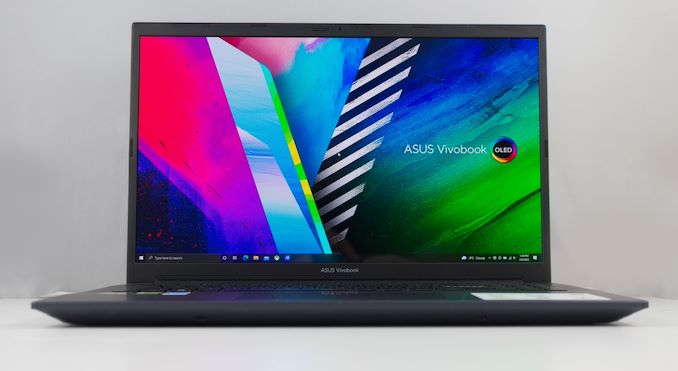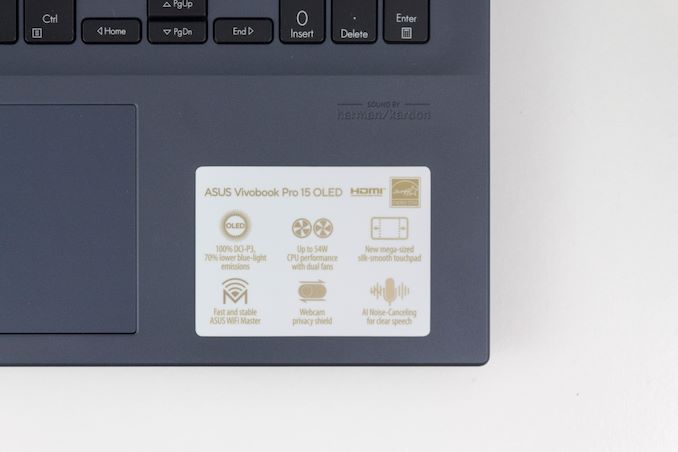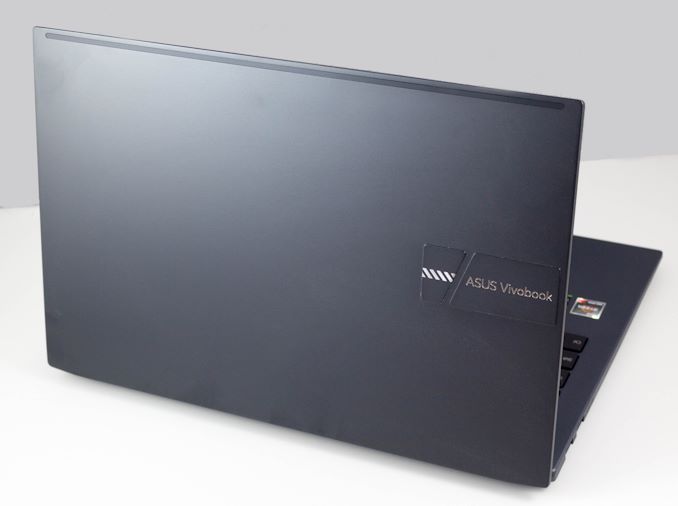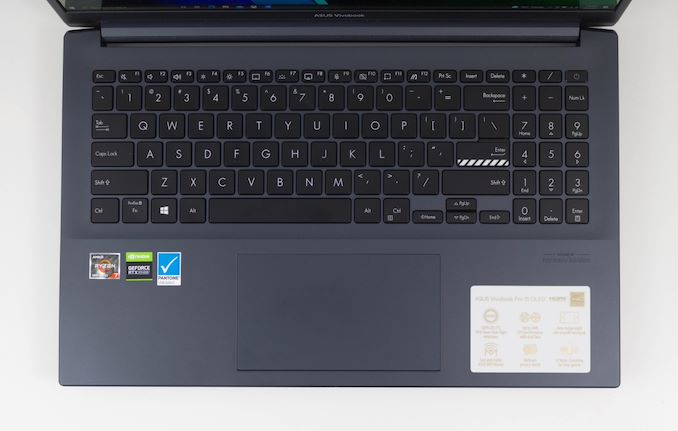The ASUS Vivobook Pro 15 OLED Review: For The Creator In All Of Us
by Brett Howse on March 7, 2022 8:30 AM EST
As the market for notebook computers has expanded, new product categories have been developed to fill the needs of a wider range of audiences, and one area that has been rapidly expanded in recent years is the Content Creator notebook. Demanding more performance than a typical thin and light notebook can provide, the creator notebooks fill a gap between gaming and light use, featuring extra graphics performance and CPU performance, while generally offering a subdued yet stylish form factor that still allows for portability.
ASUS has been building notebooks for this market for several years now, and today we are looking at the Vivobook Pro 15 OLED. The name kind of gives away the special feature of this device but including a 15.6-inch OLED display adds a major punch to the offering. Although OLED has not taken over the PC industry like it has the smartphone world, there is really nothing like the stunning contrast ratio OLED provides, as well as the wider color gamut most OLED devices support. In the case of the Vivobook Pro 15, that means 100% full coverage P3 gamut support.
ASUS provides both AMD and Intel versions of the Vivobook Pro, and the M3500 they have supplied us features the Ryzen 5000 Mobile series processors coupled with NVIDIA RTX Studio graphics. It ships with 16 GB of DDR4 RAM and 512 GB of SSD storage. Offering both AMD and Intel options is most certainly a nice feature. ASUS shipped this to us prior to the Ryzen 6000 launch and provided the Ryzen 7 5800H variant.
| ASUS Vivobook Pro 15 OLED | |||||
| Component | Ryzen 5 | Ryzen 7 Model Tested |
|||
| CPU | AMD Ryzen 5 5600H 6-core / 12-thread 19MB Cache 4.2 GHz max boost 45W TDP |
AMD Ryzen 7 5800H 8-core / 16-thread 24MB Cache 4.4 GHz max boost 45W TDP |
|||
| GPU | NVIDIA RTX 3050 Laptop Max-Q 2048 CUDA Cores 4GB GDDR6 128-bit |
||||
| RAM | 16GB DDR4 Soldered |
||||
| Storage | 512GB PCIe 3.0 SSD | ||||
| Display | 15.6-inch 1920x1080 OLED 100% P3 D65 Gamut PANTONE Validated 84% Screen-to-body ratio Glossy No Touch |
||||
| I/O | Left Side: 2 x USB 2.0 Type-A Right Side: 1 x USB 3.2 Gen 1 Type-A 1 x USB 3.2 Gen 1 Type-C 1 x HDMI 1.4 1 x 3.5mm headset Micro SD Power connector |
||||
| Networking | Wi-Fi 5 Intel 8265 Wireless NIC Bluetooth 4.2 Optional Wi-Fi 6 on some models |
||||
| A/V | Harmon Kardon speakers 720p webcam with privacy shutter |
||||
| Battery | 63 Wh Battery 120W AC Adapter |
||||
| Dimensions | 360 x 235 x 18.9 mm 14.17 x 9.26 x 0.74 inches |
||||
| Weight | 1.65 kg / 3.64 lbs | ||||
| Price (USD) | $920 | $1,099.99 | |||
There’s a reasonable amount of expandability of the device, which offers two USB 2.0 Type-A ports, a single USB 3.2 Gen 1 Type-A port, and a single USB 3.2 Gen 1 Type-C port. There is also a HDMI 1.4 connection, as well as a Micro SD card reader. For a device aimed at content creation, the port selection perhaps is not the best as a full-size SD card reader would have been preferred for offloading images from a camera, and the HDMI port rather than a DisplayPort is odd, although you can of course use an adapter from the Type-C port or HDMI to convert if needed.
ASUS offers up to Wi-Fi 6 in the Vivobook Pro 15, although the AMD review unit arrived with the Intel Wireless-AC 8265 network card which is Wi-Fi 5. It is one of the best Wi-Fi 5 devices around, thankfully.
ASUS offers the Vivobook Pro in two color choices as well. Prospective buyers can choose between Quiet Blue, which is what our review unit is, or Cool Silver.
The major feature though is definitely the OLED display. The 16:9 1920x1080 15.6-inch panel is undoubtedly the star attraction with incredibly rich blacks and vivid, punchy colors. We will of course dig into the display in more detail shortly.
ASUS packs quite a bit into the Vivobook Pro’s 1.65 kg / 3.6 lb package. Let’s dive in.
Design
The Vivobook Pro 15 OLED is a very traditional notebook design, with a 16:9 aspect ratio display that easily opens with one finger. The display back features an aluminum cladding while the main chassis of the device is polycarbonate. For the price point, ASUS has done a nice job here balancing cost versus feel, and the rigidity of the device is very solid.
The display bezels are reasonable thin, with ASUS stating the laptop offers an 84% screen to body ratio. The sides are thin and the top and bottom are wider which does help with the fitment of the webcam, although the webcam is only a 720p offering. It does offer a sliding privacy shutter which is a nice touch.
A 16:10 panel, such as the 14-inch version of this device offers, would have been a better fit with the product category as well. For content creators, having the extra vertical space on the display over a normal 16:9 panel allows for application controls while working on full-screen video.
Taking a look at the keyboard deck ASUS has fitted the Vivobook Pro 15 with a number pad to the left of the keyboard. This is always a compromise, especially on a 15-inch notebook, and does offset the keyboard to the left. ASUS was able to fit in full-size keys though and the keyboard feel is quite good. The key depressions are firm and offer a solid 1.35 mm of key travel, although they key caps themselves are flat and smooth. A bit more texture on the keys would have been nice, such as what ASUS offers on some of their ROG laptops. There is three levels of white backlighting which works well contrasting with the dark keys. ASUS does put the power button in the keyboard itself, which can cause issues accidentally pressing it, but thanks to the number pad the power button is not close to the delete key which should help.
ASUS has included an oversized touch pad in the Vivobook Pro 15 which works very well. It is incredibly smooth and responsive. It lacks some of the tactile feedback of the newer haptic touchpads but nevertheless is a good implementation. Despite the extra width, the palm rejection seems to work well as it never got in the way when typing.
The Vivobook Pro 15 offers a somewhat strange set of ports and the layout is also odd. The power connection as well as the faster USB ports are all on the right side of the notebook, which can get in the way if you were using it with a mouse and right-handed, as most people are, and the headset jack is also in the way. The power connector does offer a 90° connector which does help. Due to the 120-Watt AC Adapter, USB-C charging is not possible for maximum load, so ASUS has gone with a traditional barrel connector for power. The left side of the notebook has two USB 2.0 ports only. There is also a full-sized HDMI 1.4 port on the right side, as well as a micro SD card reader. A full-sized SD card reader would have been a better option for people wanting to pull files off a camera.
Where the Vivobook really shines though is its portability. Despite being a 15-inch notebook with a discrete GPU included, the Vivobook is still only 1.65 kg / 3.64 lbs. It is not quite a 14-inch notebook size, but the 84% screen-to-body ratio does help keep the overall dimensions in check. If you are looking for something with a proper 45-Watt processor and dedicated graphics, but still need to use it on the go, ASUS has done an excellent job on packaging.
















33 Comments
View All Comments
reuthermonkey1 - Monday, March 7, 2022 - link
I do appreciate that they denoted it does not use a USB-C charger, for example.philehidiot - Monday, March 7, 2022 - link
The Linux point is definitely a good one. I am very tempted to put Linux on my next laptop as my old one uses OSX, which I really like over Windows, but hate what Apple do to customers.If a laptop can run a specific Linux distro without excessive hassle, that would be a superb test for me. It has the potential to be a rabbit hole, so I'd suggest something like "n hour Linux install and config test" - set a specific time limit for a competent Linux user and see if they can install a popular distro, and have it configured to run all the hardware properly, within that timeframe.
I also like the proprietary charger idea. That stuff boils my piss.
brucethemoose - Monday, March 7, 2022 - link
Sometimes there's a huge difference between popular distros, usually because they run a really old kernel (Ubuntu/Debian/Mint) and/or don't support proprietary drivers (Nvidia, wifi) ootb (Fedora).And sometimes there are specific community fixes that take seconds to install, but that you might not otherwise know to look for.
Basically, I'm saying this is a tough ask for a reviewer, and such a linux "test" could be very misleading. You are better off diving into the online communities for a particular line/brand yourself.
TheinsanegamerN - Tuesday, March 8, 2022 - link
Basic things, like if it instlals, and if the dual graphics work without hassle, are simple for a reviewer to check with a couple different distros.jospoortvliet - Saturday, March 12, 2022 - link
Just test Ubuntu. Sure there are lots of distros and I personally am not an Ubuntu fan at all but reality is that it just makes sense with its user base and with the aim of keeping it simple.Oxford Guy - Sunday, March 13, 2022 - link
It really is unfortunate how Apple has not chosen to take the high road when it comes to respecting the agency of individual consumers. That is both about its high level of spying and its incessant changing of UI. It’s also about force-feeding people what certain developers there want them to eat — like relentless punishment for using low power mode in iOS.Unfortunate but not at all surprising, since these companies don’t work for ordinary individuals at all. On the contrary…
TheinsanegamerN - Tuesday, March 8, 2022 - link
It's a pain, but barrel chazrgers have two notable advantages: more resistance to force damaging the connector and port, and (IDK if its true on this machine) they can be mounted seperate fromt he botherboard, allowing easy replacement. USB C cant do this.phoenix_rizzen - Monday, March 7, 2022 - link
Would it be possible to run the graphics tests again using the integrated GPU? Would be interesting to see just what the difference is between the iGPU and dGPU. Or is that even possible on AMD-based laptops (I have no experience with laptops that include dGPU)?Could also be interesting to see what (if any) impact switching between the GPUs makes for battery life.
Alistair - Monday, March 7, 2022 - link
no point with ryzen 5000 though, you want ryzen 6000 for thatbrucethemoose - Monday, March 7, 2022 - link
Most laptops are basically unusable on battery with a loaded dGPU, unless its something barely better than an IGP.As for IGP perf, you have to stick to low intensity games on the IGP. Vega 8 is nearly an order of magnitude slower than my 2060, which is somewhat comparable to this 3050.
This is kinda why Ryzen 6000/Van Gogh are so exciting. For the first time ever, gaming on battery may actually be practical.